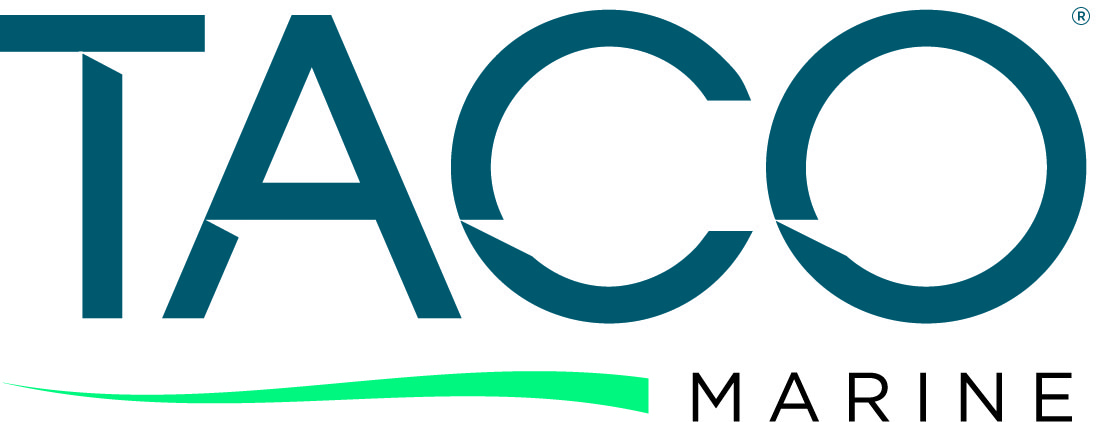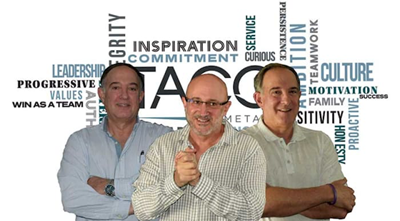This article originally ran in the July 2019 issue of Soundings Trade Only Today by Reporter Michael Verdon. Thank you to Soundings for featuring TACO and the Kushner brothers!
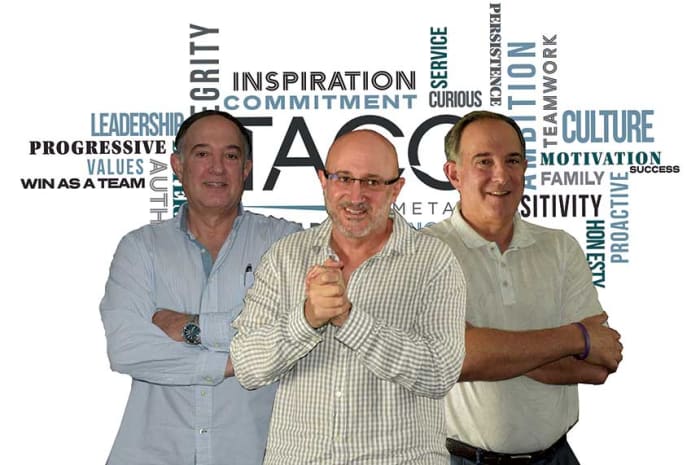
The Kushner brothers in front of the values wall at TACO’s Miami headquarters.
When Dave Kushner purchased TACO Metals nearly 60 years ago, he could not possibly have foreseen that his three sons would eventually grow it into a leading marine brand. TACO was barely a year old, a fledgling Miami-based manufacturer that made aluminum railings for South Florida’s exploding swimming-pool trade. The company wouldn’t have its first marine contract until a decade later.
Kushner, the son of a Russian immigrant, a Navy vet and a graduate of Brown University, had moved from Worcester, Mass., with his wife, Betty, and 3-year-old twins, Bill and Mike, for the sunnier climate of South Florida, which was experiencing a boom. He had been in the burlap recycling business but left that for what seemed like more promising opportunities in Miami. TACO flourished under Kushner’s management, and by 1970, he had expanded beyond swimming pools and architectural features into building aluminum railings for his first boatbuilder, Thunderbird Formula, located a few blocks away
In 1979, Mike and Bill joined the business, and by 1984, so had his third son, Jon. The boys had all graduated with business degrees and recognized the company’s potential to grow into a national marine brand. By the mid ’80s, TACO had become a primary rubrail supplier to Chris-Craft, Wellcraft, Sea Ray, Regal and Correct Craft, and there were so many sailboat builders in the Tampa Bay area that Bill opened a distribution center in Clearwater to service them.
By the end of the ’80s, TACO’s marine business had grown to about half of companywide sales, and the brand had established itself nationwide. The company had regional distribution centers in New Bedford, Mass.; Wheeling, Ill.; Orlando and Tampa, Fla.; and, in 1983, started a partnership in Kent, Wash., called TACO West. It also expanded its product lines into vinyl rubrails and sourced stainless cast parts from Taiwan. It also acquired several businesses, started product lines and launched a marine aftermarket division.
By the early 1990s, when Dave retired from the business, the Kushners were sourcing products in mainland China to fuel the company’s growth. They continued to expand into new product categories, designing specialty marine products and increasing manufacturing from their Miami headquarters. “Becoming more manufacturing-oriented is what really created our transition to the boating industry,” Jon says. “It took about 15 years to put all our emphasis on marine.”
In 2005, the company opened a facility in Sparta, Tenn., that would serve as its central distribution hub, as well as its new-product development and manufacturing center. With new-boat sales in freefall during the Great Recession, TACO had to cut workers and put growth plans on hold.
That growth came over the last seven years, and Sparta is now the primary manufacturing facility and home to a design team that turns out dozens of new products each year. TACO also recently opened a regional distribution center in Summerville, S.C. The company employs 140 people across all locations, including its Miami headquarters and seat manufacturing facility in Largo, Fla.
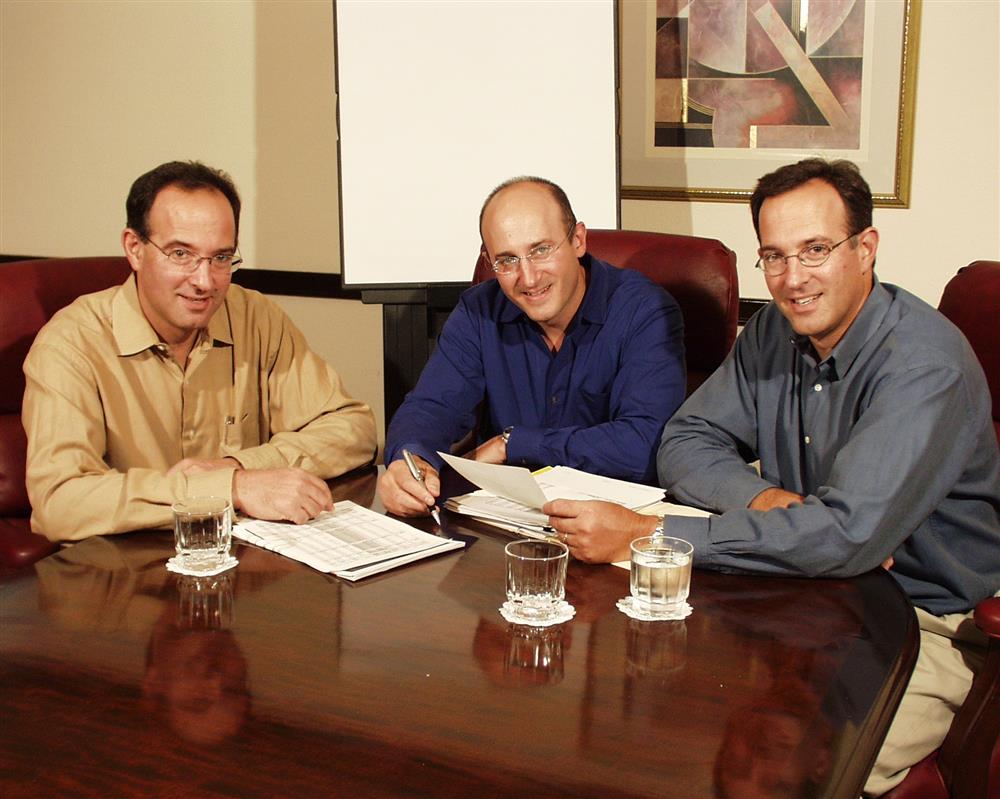 The Kushner brothers joining their father’s company in the early ’80s.
The Kushner brothers joining their father’s company in the early ’80s.
How did TACO get its name?
Mike: It was actually an acronym that was the first two letters of the original partners’ last names. It never seemed to be funny until the 1970s when Americans discovered Mexican food. It definitely gives us an advantage since it tends to be an ice-breaker for new customers.
Jon: It’s quirky, so it’s always the subject of conversation. People definitely remember it. It has served us well over the years.
When did your father buy the company?
Bill: In 1961. It had only been in business a year or two. They made protective aluminum railing systems that went around swimming pools. It was during the heyday of construction in South Florida, so that business gave him visibility for extrusions in other markets. My dad was a pretty entrepreneurial guy, so he was always looking for additional opportunities.
Is that how he got into boating?
Bill: Yes. Thunderbird Formula belonged to a holding company at the time, and they owned a houseboat factory off Biscayne Boulevard in Miami, literally in Dad’s neighborhood. He provided aluminum molding for the houseboats and then started supplying railings, which opened his eyes to marine opportunities. He was able to then develop other product lines.
For the boating segment?
Bill: The marine industry’s nerve center was South Florida, so most of our boating business was down here. We expanded our product line to include hard-to-get items and then developed a reputation for that. We started shipping to other parts of the country.
Jon: But it wasn’t a quick transition to the boating industry. For a long time, we were a specialty metals company that sold extrusions to different industries — we still sell some products to the specialty vehicle, architectural glass and railing industries. In the 1970s, we developed a core line of marine products, and that turned into a national business. We developed a niche in marine and became a bigger player. That trend accelerated after the 1970s.
Bill: As we grew into marine, we became a primary supplier to other leading Florida builders, like Sea Ray, Regal, Correct Craft and Wellcraft.
Jon: We really took off in the 1980s. We formalized our aftermarket presence in 1984, and that’s now about a third of topline sales. We also started bringing in stainless steel fittings and hardware from mainland China in the early ’80s. We’d been working with manufacturers in Taiwan since the late ’70s. Today, we outsource about a third of our products. We understand global sourcing is a matter of necessity at this point.
Mike: At that point we were also getting into other product segments. With the emergence of center console fishboats in South Florida, we introduced a full line of anodized aluminum pipe and hardware, and began supplying the makers of custom T-tops and leaning posts, which is still a major market for us.
Jon: We also started extruding in-house, as rubrails on boats moved from aluminum to plastic. We got big into vinyls and colored plastics. We reached such a critical mass at that point that we ended up working as partners with the boatbuilders. We became a primary supplier across product lines, so they didn’t have to source them from multiple suppliers.
Mike: We’ve always been focused on meeting the needs of our customers. They often asked us to make or help them find something that they didn’t have a good source on. That’s how we expanded our marine product line of extrusions, castings and fabricated parts. We’re in nearly a dozen categories now.
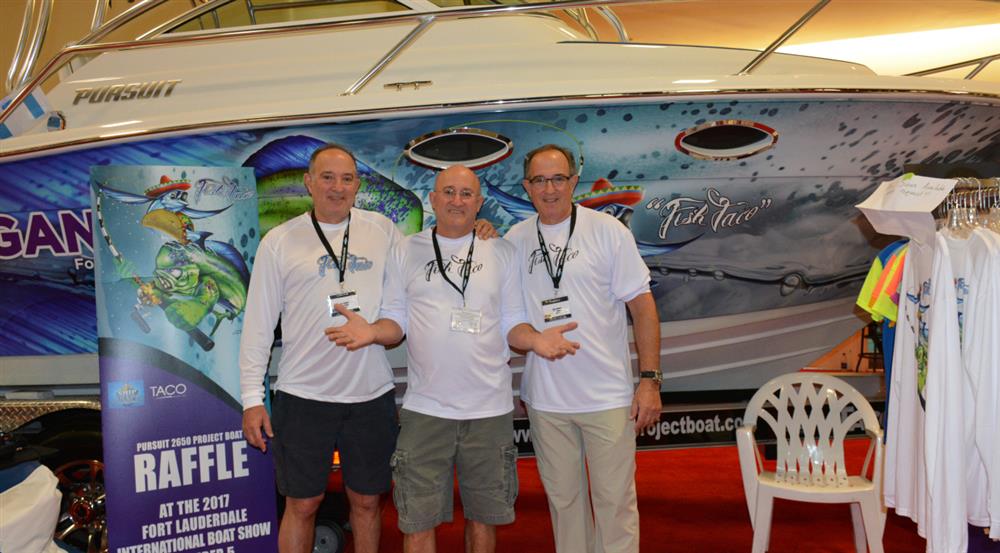 The Kushners raised $130,000 for the I’m Logan It Foundation, in honor of Mike’s son Logan, by totally refurbishing and raffling a 1989 Pursuit.
The Kushners raised $130,000 for the I’m Logan It Foundation, in honor of Mike’s son Logan, by totally refurbishing and raffling a 1989 Pursuit.
Can you talk about the facility in Tennessee?
Mike: The four hurricanes in 2004 made us decide to move manufacturing outside Florida. The hurricanes made it problematical, plus insurance rates were high. We were also bringing materials and product down to Miami and then paying freight to have it shipped north again. It made more sense to have it centrally located in Tennessee. A year later, we bought a 50,000-square-foot building in Sparta and soon added an extra 90,000 square feet in order to house both our distribution and manufacturing requirements. By 2007 we had about 70 employees working in Sparta, and we were just starting to hit our stride when the recession hit. Our OEM business dropped 60 percent overnight. It was, without question, the most difficult time in the company’s history.
Where are you at this point?
Jon: We’re back above the volume we were doing in 2007 from a sales standpoint, though we’re leaner and much healthier. Having said that, I think we’re in one of the most challenging periods that we’ve seen.
How so?
Jon: For a long time, the industry has been oversupplied. The recession never really thinned out the supply chain to any great extent, so there’s still an abundance of small suppliers. As boatbuilders have consolidated, larger companies from other industries such as RV and some others have recognized opportunities and started acquiring and rolling up marine equipment manufacturers. That has ratcheted up the pressure on companies like ours that choose to remain independent and family-run. The game has changed. It’s no longer a cottage industry when it comes to service and innovation. At least not like it was.
What do you mean?
Mike: Boatbuilders and dealers are more demanding when it comes to quality standards from the supply chain. They are looking for ways to streamline the supply chain and cut unnecessary waste. A lot of companies, unless they’re adding value in terms of service, quality and innovation, are beginning to be forced out.
Jon: It’s really an existential threat. Either you adapt to the competitiveness of this scaling up of service and product standards, or you risk being marginalized or eliminated. That’s part of the reason we expanded to Tennessee and ratcheted up our quality and product engineering programs. We want to make sure we engage at the level that is expected today. You need to develop higher levels of sophistication and expertise. We have to have our finger on the pulses of our regional boatbuilder clients. That’s why we opened another center in South Carolina.
Mike: We have to offer distribution in our builders’ backyards. The large boatbuilders know the value of just-in-time delivery, and the smaller builders like it because they don’t have to carry high levels of inventory themselves. It’s a good formula because we’re providing customized service to key accounts on a regional basis. We offer this service in Florida, the Carolinas, Tennessee and key parts of the Midwest and Northeast.
Where does the innovation come in?
Mike: Innovation is what fuels this industry. We always seek to be a step or two ahead by providing products to fit where we believe the market is headed. We’re working side by side with our builders to understand what they want or would like to see improved, and then we set out to do it in a cost-effective manner.
Bill: We have our own factory-direct sales team that goes into the plants and gathers information from all levels of the manufacturers’ organizations. A lot of people wondered why we got into marine seating, but we can integrate our seating to be more complementary with the pedestals and slides we make. We think more holistically than competitors with single product lines.
Jon: Our industry was built on the backs of small family businesses, and now is the time where those businesses have to get out in front through innovation. This is a time when marine equipment manufacturers need to reinvest in their businesses more than ever.
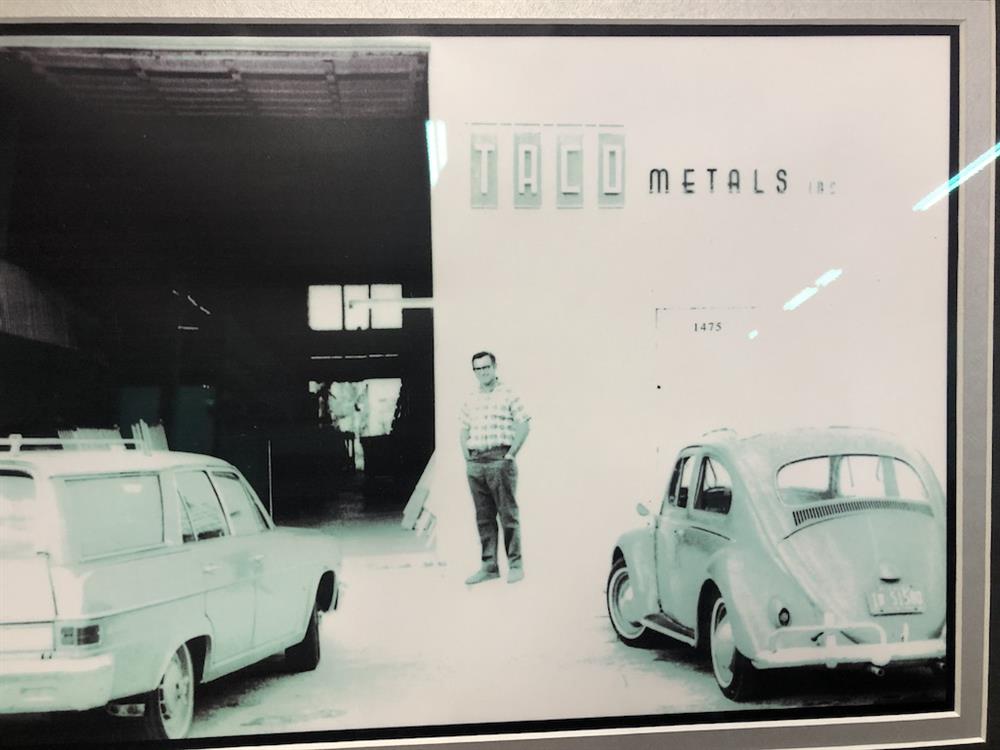
How did you reinvest in yours?
Jon: Over the past seven years we’ve invested in all areas of our business, starting with our people. We’ve upgraded throughout by bringing in stronger managers in HR, IT, engineering, QC, OEM sales and marketing. They’ve helped to improve our processes and build and train each of their teams.
Bill: We invested in our engineering team as the economy came back. There are eight people on our engineering team in Sparta who have technical backgrounds in marine. We do our own digital modeling, fatigue testing, prototype modeling and make our own 3D printed parts. We do a lot of testing before we go into full production.
Jon: We have multiple development projects for new products that we introduce on a calendar-year cycle. But we also have a lot of inner development that goes on constantly as we work with customers. Our product development team is broken down across product lines and manufacturing processes. The feedback loop with our clients happens quickly and allows for fast innovation and expanding our product lines. It’s about being fast to market with new products.
Mike: This year we had almost a dozen new products that are considered innovative. But we also do redesigns of existing products to stay ahead of our many competitors. If you want to be a leader in innovation, you have to be a step or two ahead — even if the competition isn’t there.
Jon: Between what we manufacture in-house and what we outsource, we have a broader perspective on what can be done with innovative solutions than any one of our customers. We have many materials in our supply chain, so we can go in and find the best solution. Many times that involves taking the solution in an entirely different direction than what we’re doing today.
Bill: It’s a more complex business than people realize because we’re into so many different product lines and manufacturing processes. Just controlling design and engineering and working with outside suppliers — domestic and overseas — requires a high level of knowledge.
How is the business now compared to when you started with your father?
Bill: It’s a different kind of business and much more difficult than 20 or 30 years ago. Everything is happening much faster, at a more demanding pace. If we were independent owners without the family values we inherited from our father, it would be difficult at times, and maybe it wouldn’t even work during the really challenging points. But we understand that we have to be there for the business and can’t just let it be an extension of our family. We are also fortunate to have a strong management team in place underneath us to help lead our continued growth.
Jon: Our industry is full of family businesses. Many of our clients are family-run boatbuilders. We understand who they are. We don’t take a hammer-and-nail approach to the business. We bring a bag of tools to each client and try to figure out the best solutions. Most of all, we strive to be great at what we do.
Mike: Between the three of us, we have 100 years of experience in marine. We also have a number of team members who have been with us for 25-plus years and bring a wealth of experience. This, combined with the expertise that the rest of our team members bring, truly makes TACO the company we are today. It’s what keeps us energized and excited about our future.
This article originally appeared in the July 2019 issue.
